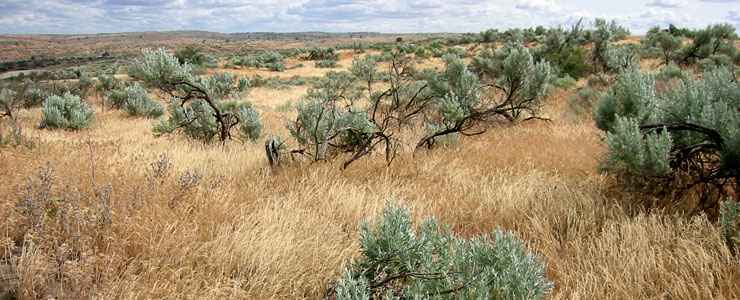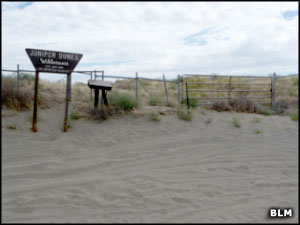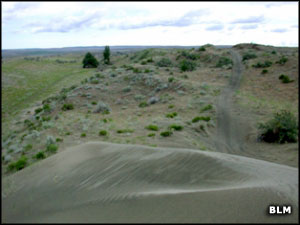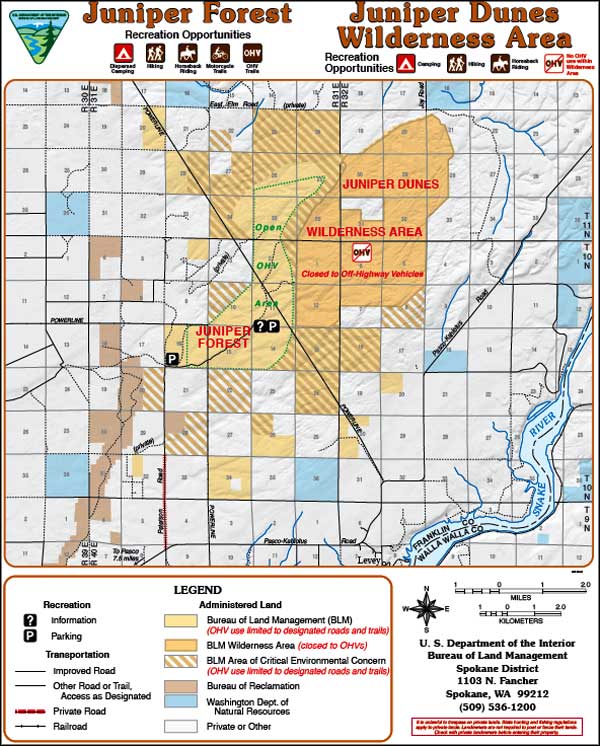Juniper Dunes Wilderness

Juniper Dunes Wilderness

Juniper Dunes Wilderness is a 7,100-acre property in southeastern Washington administered by the Bureau of Land Management. What you'll find here are loose, windswept sand dunes up to 130 feet high and 1,000 feet long hiding the northernmost stands of Western juniper, some specimens of which are as much as 150 years old. Except for the junipers there are almost no other trees in the wilderness.
Elevations at Juniper Dunes Wilderness run from a low of about 750 feet to a high of about 1,130 feet. The prevailing breeze is from the southwest and tends to be rather dry. That builds the dunes up and moves them around. Precipitation in the area averages about 8 inches per year, and that includes about a foot of snow that appears annually in the depths of winter. This is an area that can see 50°F or more differences between high and low temperatures on the same day.
Among the wildlife found on Juniper Dunes Wilderness are bobcat, badger, mule deer, coyote, weasel, skunk, kangaroo rat, pocket gopher, porcupine, raven, quail, hawk, owl, pheasant, dove, partridge, songbirds and rattlesnakes.

Virtually all the land around Juniper Dunes Wilderness is privately owned so to visit the wilderness, you might need to obtain permission directly from the land owner. It seems there is some kind of deal in place for folks to use the Peterson Road (near the southwestern corner of the property) but it's dependent on public behavior and land-owner cooperation. There are a couple other ancient jeep trails that almost reach the wilderness boundary but they are all in horrible condition and they all have that same private property problem. Wilderness Road is the last bit of jeep trail between Peterson Road and the wilderness gate and it might be completely impassable depending on the season and the recent weather. Summers are particularly bad as there is little moisture to dampen the sand and hold it together. You'll still need permission to cross the private land but you could park at the Off-Highway Vehicle staging area on Juniper Road and walk the 1+ miles to the gate. Within the wilderness area there is no water and no maintained trails. You'll know when you get there because the wilderness area is fenced and signed.
(Just a few years ago the "years of use" rules applied to public trails that crossed private property to access public land. Years of public trashing of the private land led to many confrontations and court cases. Now, under the Trump administration, private landowners are finding it's possible to completely block all public access to public property and treat that property as if it were their their own. They also don't pay any form of taxes for it... the faceless public picks up that bill, too.)
The Juniper Dunes Recreation Area includes the Juniper Dunes Wilderness and Juniper Forest, a 3,920-acre Off-Highway Vehicle area, and the 8,620-acre Juniper Dunes Area of Critical Environmental Concern, an area designated for "limited" OHV use. Because there are no developed OHV trails in the area, that "limited" is a moot point: OHV use is prohibited in the area. Even within the OHV area OHV use is limited to existing trails and roads, cross-country use is not allowed.
The Juniper Dunes Recreation Area (Wilderness, OHV area and non-OHV area) are open year round. There are no fees involved in using the property but you might still need permission to cross that private land to get there...

Smaller photos and map courtesy of the Bureau of Land Management